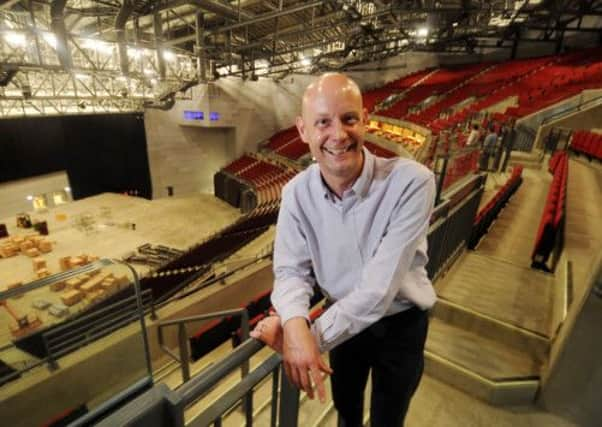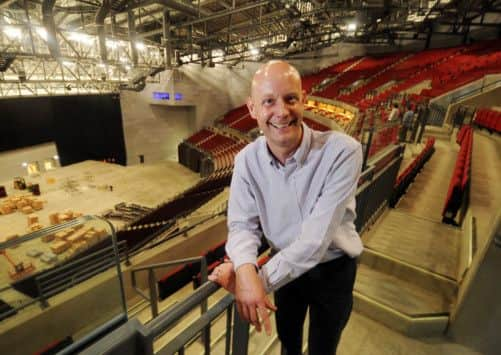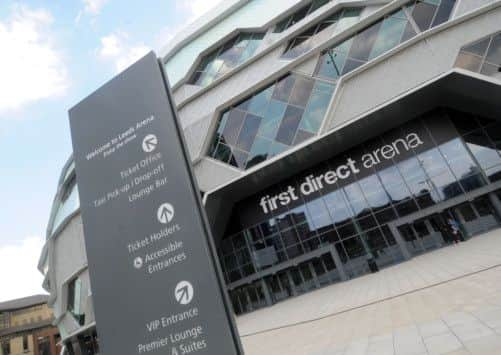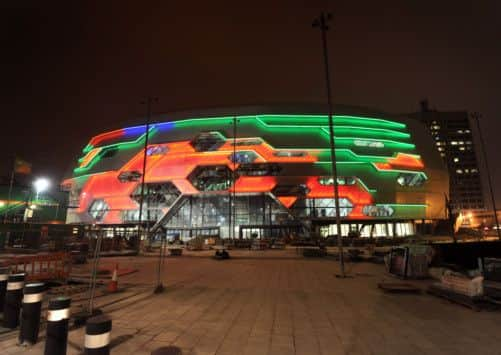Video: Springsteen at Leeds Arena - access all areas


THE stage area is littered with giant boxes being unpacked, cleaners are busy dusting row after row of seats and the tannoy system reverberates around the cavernous amphitheatre.
Even now, as the finishing touches are being made, it’s hard not to be impressed. But come Wednesday night there won’t be a spare seat, or standing space, in the house as rock superstar Bruce Springsteen takes to the stage for the opening, sell-out gig at the £60m First Direct Arena.
Advertisement
Hide AdAdvertisement
Hide AdLeeds has waited an awfully long time to get its own arena and now it finally has one. The official launch might not be for another six weeks, when Sir Elton John plays here, but as prelaunch shows go they don’t come much bigger or better than the man they call “the Boss”, whose songs include Born in the USA, Thunder Road and Dancing in the Dark.


The city’s leaders have talked about the need for an arena like this for the best part of 20 years, but all the while some of the world’s biggest rock and pop stars bypassed the city in favour of places like Newcastle, Nottingham or Sheffield. In the past the only time they came to Leeds was to perform open air at places like Roundhay Park, or as part of the Leeds Festival. But not any more.
The 13,500-capacity arena, operated by private firm SMG Europe, was built with Leeds City Council money and has been completed both on time and on budget, which is no mean feat in these days of frequently spiralling costs. It has already been hailed as the most exciting new venue of the year by the influential US magazine Billboard and looking around the building it’s easy to see why.
The huge performance area has been designed so that no one in the audience is more than 60 metres from the stage and Ben Williams, the arena’s general manager, describes it as an “amphitheatre with a roof.” “Most bowl arenas were designed originally for sport and then converted for entertainment which meant people were opposite you and the stage was to the side. But with this arena everyone is facing the stage, it’s more intimate and there’s no reduced viewing. It’s the future of arena design.”
Advertisement
Hide AdAdvertisement
Hide AdHe says the arena’s acoustics, which includes high quality acoustic panels in the walls, also lead the way. “By arena standards we’ve exceeded previous norms and set a new benchmark in acoustics for arenas,” he says.


The vast majority of people you speak to in Leeds are pleased that the city finally has an arena, although not everyone is impressed at its appearance from the outside, with critics likening it to a 1960s leisure centre, a giant caravan and even an opal fruit. Certainly by day it looks fairly unremarkable but at night the building is lit up by an ever-changing kaleidoscope of colours and has already become a landmark on the city’s skyline.
Williams, though, isn’t particularly fussed what it looks like on the outside. “What is important is that it connects to the city and I think it does that. But for me it’s all about what happens inside.”
The Springsteen concert came out of the blue when SMG was contacted by his promoters who asked whether the arena in Leeds could be ready in time. “It was never planned and never expected,” says Williams, “but when it’s someone like Bruce Springsteen you find a way to make it happen. He’s pretty much the perfect prelaunch show, he’s a genuine rock superstar and he’s a man of the people.”
Advertisement
Hide AdAdvertisement
Hide AdAs a result of bringing forward the opening night there are still a few “cosmetic” touches missing, like advertising posters, but the staff are ready for the big opening, as are the bars and merchandise stalls that will no doubt be doing a roaring trade with punters eager to soak up the atmosphere and pick up a souvenir or two.


The council took on the role of developer for the arena four years ago and Martin Farrington, director of development, says they have achieved what they set out to do. “It was important that we delivered an arena that was on budget and met the city’s desires as well as SMG’s performance requirements.” He believes, too, that the £60m venue offers good value for money. “There was an arena built in Glasgow at the same time which cost £100m. You have to be realistic about what your design aspirations are when you have a budget and we have a very well designed building that is clearly identifiable as the arena in Leeds, it’s a unique venue.”
One of the reasons Leeds went so long without an arena was because of disagreements over where to build it, with Elland Road earmarked as a potential site at one time. The question of traffic congestion and the impact on the city’s roads was also one of the main issues, which is why the council has come up with a detailed plan that it hopes will minimise any disruption.
“The arena is designed to make full use of the city centre and there are more than 2,500 car parking spaces very close by at the Merrion Centre and Woodhouse Lane, and over 7,000 within 15 minutes walk. So from an audience point of view it means they can choose how they want to plan their visit.”
Advertisement
Hide AdAdvertisement
Hide AdThe council also has a team of 120 volunteers, or “city ambassadors”, who will be greeting people arriving at the train and bus stations and other key access points to the city, to help direct them to car parks and to the arena. Sue Burgess, city development manager who is co-ordinating the operation, says the aim is to make the opening night run as smoothly as possible. “We’re determined to get it right first time because we want people who come to Leeds to leave with a great impression of the city.”
As well as putting Leeds back in the limelight for music, the new arena has had a much wider economic impact, with more than 90 apprentices involved in its construction and 82 local businesses working directly on the project.
It’s been estimated that the arena will bring more than £25m into the city each year and council leader Keith Wakefield says it’s a huge boost for the city. “We have waited a very long time to get this significant piece of the city’s cultural jigsaw in place and now we have it.”
He says the arena also shows that local authorities can successfully deliver big projects and play an important role in driving cities forward. “It’s not just about the arena, it’s about the cultural ambitions of the city and the council by working together has shown the imagination, ambition and vision to make this happen.”
Advertisement
Hide AdAdvertisement
Hide AdFor all the excitement, the building hasn’t been without its controversies, though. When it was first announced that Leeds was finally getting an arena there were concerns about the possible impact it might have on Sheffield, which already has its own similar venue.
But coun Wakefield doesn’t see why they can’t both flourish. “There are five million people in the region and that’s big enough for two arenas. There’s less distance between Manchester and Liverpool and they have their own arenas and I think the new Leeds Arena will appeal to people in West and North Yorkshire and Sheffield has its own catchment area.”
With the opening of Trinity Leeds in March, the Tour de France’s Grand Depart coming next year, and the new arena, he believes these are exciting times for the city. “We’ve got Opera North, we’ve got Northern Ballet, City Varieties, the Playhouse and the Grand. Leeds is recognised as a world class cultural city and we now have the missing piece of the jigsaw,” he says.
“We’ve got a world class venue for world class artists and we have people like Bruce Springsteen, Elton John and Rod Stewart queuing up to come and play in Leeds.”